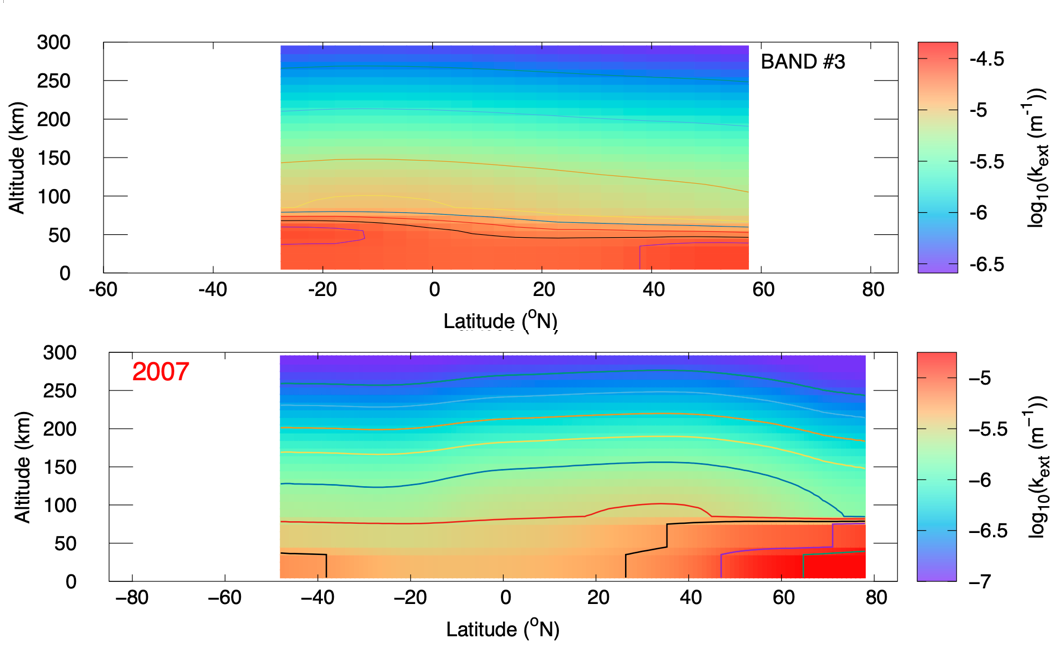- 1Université de Reims, GSMA, Reims, France (pascal.rannou@univ-reims.fr)
- 2LESIA, Obs. de Paris, PSL Research University, CNRS, Sorbonne Universités, UPMC Université Paris 6, Université Paris-Diderot, Sorbonne Paris Cité, 5 place Jules Janssen, 92195 Meudon, France
- 3Institut de physique du globe de Paris (IPGP), Université Paris Cité, CNRS, 75005, Paris, France
- 4SQUARES, Universit ́e Libre de Bruxelles, 50 Av. F.D. Roosevelt, Brussels, B-1050, Belgium.
- 5Jet Propulsion Laboratory, California Institute of Technology, Pasadena, CA, USA
- 6Planetary Systems Laboratory, NASA Goddard Space Flight Center, 8800 Greenbelt Road, Greenbelt, 20771, MD, USA.
The photochemical haze layer in the stratosphere above about 80 km and the condensation haze (hereafter, mist) in the lower stratosphere and troposphere completely cover Titan and play a dominant role in its climate. These hazes determine the atmospheric radiative balance and are also good tracers of the atmospheric circulation. Spatial and temporal characterization of the haze is therefore essential for understanding Titan's climate. It is also an important step towards accessing surface properties and cloud characteristics. Recently, the James Webb Space Telescope (JWST) has provided observations of very high spectral quality. These images and spectra provide information on the latitudinal distribution of haze, from the lower stratosphere (100-150 km) down into the troposphere with good vertical resolution. With this dataset, we are able to describe the mist layer in five distinct sublayers : the deepest layer between 0 and 40 km and four layers of 10 km thickness between 40 and 80 km. The retrievals performed allow us to reconstruct a map of the haze and mist layer on the date of observation (5 November 2022) and thus highlight haze distributions related to circulation. For this analysis, we used a plane-parallel model and thus we are restricted to latitudes between -30°S and 60°N. In details, we found a photochemical haze layer increasing from the north to the south, as expected. Below 80 km, the mist layers have a more complex distribution. The deepest layer (below 40 km) has an opacity minimum near the equator and increasing toward both poles. The opacity of the mist layer between 40 and 80 km gradually changes, from bottom to top, to reach a monotonously increasing opacity from the south to the north, as for the stratospheric haze. In all bands, we find a marked opacity feature above 50 km, south to 10°S, that form a detached mist layer slightly emerging from the background opacity. We could also retrieve the surface reflectivity, with a quite low spatial resolution, that will also be discussed. With the same model, we also analyzed a selected part of the huge VIMS/Cassini data set. We could monitored, albeit with a lower vertical resolution, how these hazes evolve over the season. Here the mist layer is described in only three distinct layers but the observation set spans from 2004 to 2017. During Cassini era, we probe the seasonal change of the haze and the mist layer and have a view on the seasonal modulation of all the layers. These results allow for putting in context the results obtain with the JWST. Moreover, it also offers an interesting comparison for the results obtained with JWST since Cassini observed the opposite season, in 2007. Finally, we can fully understand our results with the help of the Titan Planetary Climate Model (PCM), now coupled with haze and cloud microphysics. This model predicts the evolution of the haze and the mist within the seasonal cycle. The haze layer is transported by dynamics and its distribution is fairly straightforward to understand. The mist, in addition, is also controlled by thermodynamical conditions which must be modeled in detail to be predicted. Then, the mist layers, less opaque in the equatorial region and increasing toward the mid-latitudes and the detached mist layer found with the JSWT are described by the PCM and correlated to the hadley-type cell below 80 km and to the temperature latitude profile. Figure 1 shows the haze and mist layers retrieved in our work. Over the JWST lifetime, we hope to complete the seasonal survey of atmospheric properties for the upcoming period from the northern autumn equinox to the winter solstice. This is a poorly observed period but corresponds to a complete reversal of atmospheric circulation. Significant changes are expected to be observed during this period. With the upcoming very large telescopes (EELT, TMT, etc.) with high sensitivity and spectral resolution, this work shows that an increase in spectral resolution translates - up to a certain point - into an increase in vertical resolution. Finally, the complete characterization of haze and cloud cycles, with models and constraints from the most precise observations possible, is a major objective to prepare for future missions to Titan; Dragonfly but also those which may be decided upon in the near or distant future.

Figure 1 : Haze and mist extinction retrieved with the NIRSpec/JWST (5 Nov 2022) (top) and with VIMS/Cassini (2007) (bottom) at 2 μm. The sub-solar latitude was in the northern hemisphere (12.62°N) at the JWST observation date and in the southern hemisphere (between 14.25°S and 8.90°S) during the year 2007.
How to cite: Rannou, P., Bézard, B., Lellouch, E., Rodriguez, S., Es-Sayeh, M., West, R., de Batz de Trenquelléon, B., and Nixon, C.: Titan haze and mist layers observed by Nirpsec/JWST and comparison with inversions from VIMS/Cassini and Planetary Climate Model of Titan., Europlanet Science Congress 2024, Berlin, Germany, 8–13 Sep 2024, EPSC2024-412, https://doi.org/10.5194/epsc2024-412, 2024.